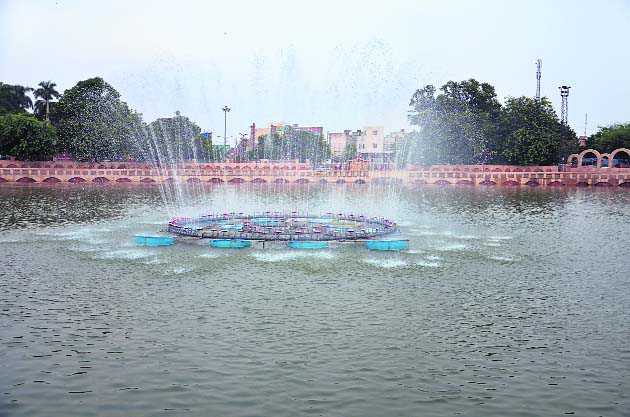‘Rani Talab’ a distinct symbol of Jind city
Satyawan Malik
‘Rani Talab’ is known as the symbol of Jind city. It is situated almost at the centre of the city. The ‘Talab’ that has a temple at the centre presents a magnificent view.
‘Rani Talab’ was built around 1875 by King Raghubir Singh of the princely state of Jind. He represented the Phulkian dynasty of which the Maharaja of Patiala was the head. Before Jind became a ‘riyasat’, it was part of Patiala province. Raghubir Singh was popularly known as Jindia Raja; his son Ranbir Singh though was called Bola Raja or the deaf king. Raghubir Singh got built Shri Hari Kailash Mandir or Bhuteshwar Mandir in the size of the silhouette of the Golden Temple of Amritsar in miniature. The temple lies at the centre of the ‘Talab’ and both are round in shape. There used to be a big fort adjoining ‘Rani Talab’, which was demolished in the nineties. A wide tunnel that connected the fort with ‘Rani Talab’ is still there. Popular beliefs go that the queen used to take bath in the ‘Talab’, and the tunnel was used as a route to avoid public glare. After bathing, the queen used to offer prayers to deities in the temple. The temple is devoted to Lord Shiva, who is also called Bhootnath in the area.
For over a decade since 2002, there was no water in the ‘Talab’. It wasn’t cleaned for years. As a result, thick grass and moss grew in wetland type conditions with lotuses floating. Some people, who jumped from 12-foot high into the 15-foot deep ‘Talab’, got stuck under water. Then the local authorities decided not to fill it with water. Even rainwater was’t allowed to accumulate in it. Boys started playing cricket in the dry tank. More or less, it remained unattended for many years before local social activists led by Prof OP Gupta took the initiative and pain to renovate and repair its boundaries. As much as Rs 80 lakh provided by the Haryana Government was spent on tile tracing and iron grills. Later, the Kurukshetra Development Board (KDB) adopted the ‘Talab’ so as to maintain and beautify it and develop it as a tourist place. The KDB has spent a large amount of money on its beautification and upkeep.
The significance of the place increases as it is situated about 5 km from the religious ghats of Pandu Pindara, the place where Pandava are believed to have come to wash their blood-stained weapons, take a bath and rest after having won the battle of the Mahabharata at Kurukshetra. People in large numbers from all over India visit Pandu Pindara on Amavasya, especially on Mondays. People throng the city from ‘Rani Talab’ to the ghats. Elaborate arrangements are made on the occasion.
The view of ‘Rani Talab’ is marvellous. Its loveliness increases as the sun goes down and lights are switched on. Fountains with colourful lights add to the attraction. People come to the temple and enjoy boating, especially during the summer to get relief from heat and boredom. The lights of shops and in the surrounding and moonlight get reflected in its not-so-clean water, giving a spectacular view on starry nights.
Some scenes of Balraj Sahni and Tanuja-starrer “Pavitra Paapi” (1970) ware shot at ‘Rani Talab’. Prikshit Sahni is seen singing the song “Teri Duniya Se Hoke Majboor Chala” at ‘Rani Talab’. Things have undergone vast changes since then. Now, its beauty appeals to the heart and the mind alike.
(The writer is Associate professor of English, Government College, Jind)









